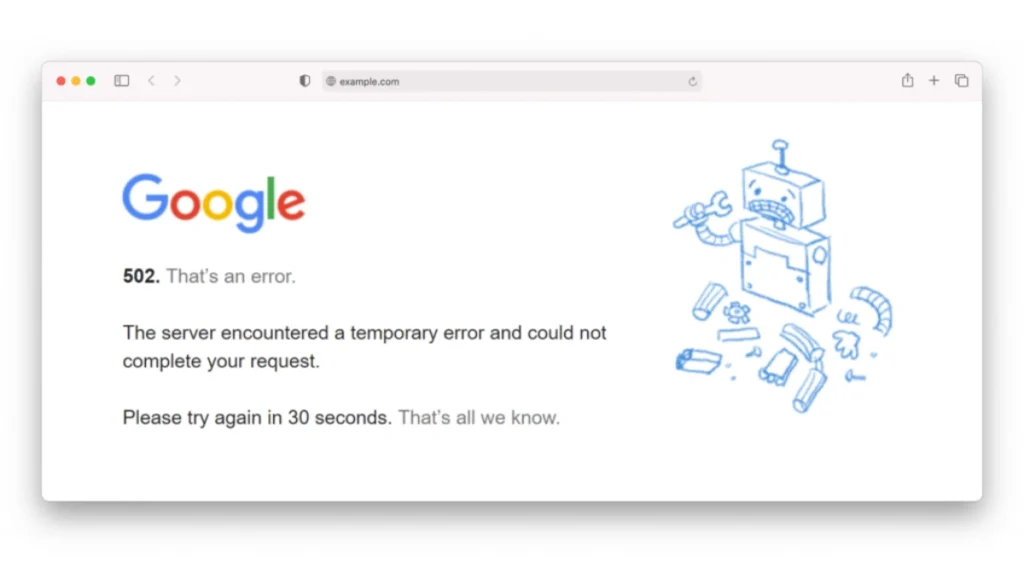
If you’ve ever browsed a website and come across an error message that reads “502 Bad Gateway,” you may have wondered what it really means. It’s one of those frustrating HTTP status codes that tells you something’s wrong but does not always explain what.
In simple terms, a 502 Bad Gateway error happens when one server, which is trying to talk to another server, doesn’t get a valid response. So, the server you’re visiting (acting like a “gateway” to another server) can’t fetch the information it needs, and this leads to the error. Imagine trying to send a message to a friend, but they don’t respond. You’re left hanging, and that’s basically what happens with a 502 error.
According to Google’s 2021 Web Vitals, a slow or broken website, such as a page that loads with an error like 502, can drastically drop a user engagement level by 35 percent, and the visitors most likely to bounce will not wait for the page to load in full. Well, the silver lining is you may recover things quickly by following troubleshooting steps.
Let’s understand what a 502 Bad Gateway error is and how to fix it when you encounter it.
Types of 502 Error Messages You May See
The 502 error does not always appear in the same exact wording. Depending on the cause, you may encounter varying messages such as:
- 502: Bad Gateway Error
- Error 502
- HTTP Error 502: Bad Gateway
- 502 Service Temporarily Overloaded
- 502 Proxy Error
- A blank white screen
- 502 Server Error: The server encountered a temporary error and could not complete your request
- Temporary Error (502)
- 502 Bad Gateway Cloudflare
However, at the bottom line, they refer to the same problem: some sort of communication issue between servers.
Also Read:- How to Select SEO Tools for Your Startup
Why Does the 502 Error Occur?
The possible reasons for a 502 Bad Gateway error include the following. It is like trying to pass a message; however, there seems to be a problem along the way. Let’s look at the most frequent reasons behind this error:
1. Server Overload or Timeout
Websites can get a lot of traffic, especially if something important is happening. If too many people are trying to go to a site at the same time, the server may get overwhelmed and unable to respond in time. This makes the proxy server angry and displays a 502 error.
2. Server Downtime
Sometimes, the server you’re trying to reach might be down, maybe for maintenance or because of some technical issues. When the proxy server can’t get the response it expects from the upstream server, the 502 error pops up.
3. Network Problems
When a 502 error arises, it results from a failed communication between different servers. Most probably, one of the things that could fail is the server side of a website or just the proxy server. The signal does not proceed, and so you see that error.
4. Firewall or Security Blocks
Firewalls are there to protect websites from malicious traffic. Sometimes, however, they can be a bit too aggressive and block legitimate communication if they think there is a threat. This may also lead to a 502 error.
5. Application Errors (Like Web Servers and Databases)
Apache or Nginx servers, and the MySQL database will go wrong sometimes when trying to process a request. In case one application goes wrong, a 502 Bad Gateway could happen.
How to Fix the 502 Bad Gateway Error?
Don’t freak out when a 502 error pops up! Actually, here are a few troubleshooting methods you can do to correct it. Some fixes are basically a no-brainer. Others could take a bit more effort. And just to ensure you won’t make a mess, here’s a step-by-step guide:

1. Refresh the Page
Sometimes, all you need is a quick refresh to solve the problem. Sometimes, websites, especially high-traffic ones, will go through minor glitches. If the error was temporary, refreshing the page may bring everything back online. You can also try a hard refresh (press CTRL + F5 on Windows or CMD + SHIFT + R on Mac) to clear out the cached data for that page.
2. Clear Your Browser Cache
If refreshing didn’t work, then the problem may be with the cached data in your browser. Browsers tend to store website information such as images and files for quicker visits in the future. However, if the cached data is corrupted or outdated, it can lead to a 502 error.
Go to your browser’s settings and locate the option that says clear browsing data. From there, you can delete only the cache and cookies. You can avoid wiping out other stuff like your history or saved passwords.
3. Try Incognito Mode
If clearing the cache didn’t help, it’s worth testing the site in Incognito Mode (or Private Browsing). In this mode, your browser won’t use the cache or any extensions, which can help rule out issues caused by extensions.
4. Test Another Device or Network
Sometimes, the problem might be specific to your device or network. Try accessing the website on a different device, like your phone. You could also try using mobile data instead of Wi-Fi. If it works on another device or network, then the issue might be with your original device or connection.
5. Error Log Check
If you run a website, especially on a platform like WordPress, you can check the error logs. These logs will help you trace down what’s causing the 502 error. WordPress allows you to turn on error logging via the wp-config.php file. If there’s a problem with a plugin or theme, it’ll probably appear in the log.
6. Disable Plugins or Themes (WordPress)
WordPress users may encounter the 502 error if there is a problem with some plugins or themes. Try disabling all plugins and switching to a default theme to see if the error goes away. You can then enable plugins one by one to figure out which one is causing the issue.
7. Check CDN (Content Delivery Network)
If you employ a CDN. This helps host your website in various locations distributed across the entire globe. Could be causing that 502. Try disabling CDN temporarily to solve the problem
8. Examine your firewalls
Sometimes, the firewall that is normally placed on the server could block communication; this can be if the firewall has detected something suspicious. In case you suspect that your firewall must be blocking it, then try to disable it and see if it loads the website; once it loads, then update the firewall rules.
9. PHP Timeout
If your PHP scripts are too slow-running (such as when doing a big site migration), this could cause a 502 error. If you think that a timeout is an issue, you can reach out to your hosting provider and request that they raise the PHP execution time limit.
10. Contact Hosting Support
If you’ve tried everything and the problem persists, it’s time to contact your hosting provider’s support team. They can help diagnose and fix issues on the server side.

Also Read:- What Is Spatial Computing?
Conclusion
The 502 Bad Gateway error can be a bit tricky to fix, but with a few troubleshooting steps, you can usually get things back on track. Whether it’s an overloaded server, a misconfigured proxy, or an issue with your DNS, the problem is typically solvable. If all else fails, don’t hesitate to reach out to your hosting provider—they’re there to help!
Frequently Asked Questions (FAQs)
Q. What is the 502 Bad Gateway meaning?
A 502 Bad Gateway error is an error code that occurs when a server acting as a gateway or proxy fails to receive a valid response from an upstream server, resulting in a communication failure.
Q. What causes a 502 error?
A 502 error is caused by overloading of the server, a misconfigured proxy server, network issues, and problems with DNS settings or firewalls.
Q. How to fix the 502 Bad Gateway?
You can refresh the page, clear your browser cache, or disable plugins and themes (if you are using WordPress). You may also check the status of your server.
Q. Is the 502 error a client-side error?
No, it is a server-side error; that is, the problem is with the server of the website or the one it is trying to connect to.
Q. What should I do if I keep seeing the error 502?
If you are experiencing repeated error 502, then look for information on whether this is down for everyone or just for you. Try different devices, clear your cache, and contact the hosting support of the website if necessary.







